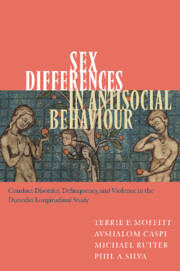Crossref Citations
This Book has been
cited by the following publications. This list is generated based on data provided by Crossref.
MOFFITT, TERRIE E.
ROBINS, RICHARD W.
and
CASPI, AVSHALOM
2001.
A COUPLES ANALYSIS OF PARTNER ABUSE WITH IMPLICATIONS FOR ABUSE‐PREVENTION POLICY*.
Criminology & Public Policy,
Vol. 1,
Issue. 1,
p.
5.
Dennison, Susan M.
and
Stewart, Anna L.
2001.
Child maltreatment and onset of offending: Implications for criminal career paths.
The Australian Educational and Developmental Psychologist,
Vol. 18,
Issue. 2,
p.
57.
Talley, Nicholas J
Howell, Stuart
and
Poulton, Richie
2001.
The Irritable Bowel Syndrome and Psychiatric Disorders in The Community: Is There A Link?.
American Journal of Gastroenterology,
Vol. 96,
Issue. 4,
p.
1072.
Roberts, Brent W.
Caspi, Avshalom
and
Moffitt, Terrie E.
2001.
The kids are alright: Growth and stability in personality development from adolescence to adulthood..
Journal of Personality and Social Psychology,
Vol. 81,
Issue. 4,
p.
670.
Hipwell, Alison E.
Loeber, Rolf
Stouthamer‐Loeber, Magda
Keenan, Kate
White, Helene R.
and
Kroneman, Leoniek
2002.
Characteristics of girls with early onset disruptive and antisocial behaviour.
Criminal Behaviour and Mental Health,
Vol. 12,
Issue. 1,
p.
99.
Feiring, Candice
Deblinger, Esther
Hoch-Espada, Amy
and
Haworth, Tom
2002.
Romantic Relationship Aggression and Attitudes in High School Students: The Role of Gender, Grade, and Attachment and Emotional Styles.
Journal of Youth and Adolescence,
Vol. 31,
Issue. 5,
p.
373.
Jaffee, Sara R.
2002.
Pathways to adversity in young adulthood among early childbearers..
Journal of Family Psychology,
Vol. 16,
Issue. 1,
p.
38.
Robins, Richard W.
Caspi, Avshalom
and
Moffitt, Terrie E.
2002.
It's Not Just Who You're With, It's Who You Are: Personality and Relationship Experiences Across Multiple Relationships.
Journal of Personality,
Vol. 70,
Issue. 6,
p.
925.
Odgers, Candice L.
and
Moretti, Marlene M.
2002.
Aggressive and Antisocial Girls: Research Update and Challenges.
International Journal of Forensic Mental Health,
Vol. 1,
Issue. 2,
p.
103.
Moffitt, Terrie E.
2002.
Teen‐aged mothers in contemporary Britain.
Journal of Child Psychology and Psychiatry,
Vol. 43,
Issue. 6,
p.
727.
Lahey, Benjamin B.
Loeber, Rolf
Burke, Jeffrey
Rathouz, Paul J.
and
McBurnett, Keith
2002.
Waxing and waning in concert: Dynamic comorbidity of conduct disorder with other disruptive and emotional problems over 17 years among clinic-referred boys..
Journal of Abnormal Psychology,
Vol. 111,
Issue. 4,
p.
556.
Mill, J S
Caspi, A
McClay, J
Sugden, K
Purcell, S
Asherson, P
Craig, I
McGuffin, P
Braithwaite, A
Poulton, R
and
Moffitt, T E
2002.
The dopamine D4 receptor and the hyperactivity phenotype: a developmental-epidemiological study.
Molecular Psychiatry,
Vol. 7,
Issue. 4,
p.
383.
Krahé, Barbara
and
Greve, Werner
2002.
Aggression und Gewalt: Aktueller Erkenntnistand und Perspektiven künftiger Forschung.
Zeitschrift für Sozialpsychologie,
Vol. 33,
Issue. 3,
p.
123.
Caspi, Avshalom
McClay, Joseph
Moffitt, Terrie E.
Mill, Jonathan
Martin, Judy
Craig, Ian W.
Taylor, Alan
and
Poulton, Richie
2002.
Role of Genotype in the Cycle of Violence in Maltreated Children.
Science,
Vol. 297,
Issue. 5582,
p.
851.
Hartung, Cynthia M.
Milich, Richard
Lynam, Donald R.
and
Martin, Catherine A.
2002.
Understanding the relations among gender, disinhibition, and disruptive behavior in adolescents..
Journal of Abnormal Psychology,
Vol. 111,
Issue. 4,
p.
659.
Granic, Isabela
and
Dishion, Thomas J.
2003.
Deviant Talk in Adolescent Friendships: A Step Toward Measuring a Pathogenic Attractor Process.
Social Development,
Vol. 12,
Issue. 3,
p.
314.
Ehrensaft, Miriam K.
Wasserman, Gail A.
Verdelli, Lena
Greenwald, Steven
Miller, Laurie S.
and
Davies, Mark
2003.
Maternal Antisocial Behavior, Parenting Practices, and Behavior Problems in Boys at Risk for Antisocial Behavior.
Journal of Child and Family Studies,
Vol. 12,
Issue. 1,
p.
27.
Storvoll, Elisabet E
Wichstrøm, Lars
and
Pape, Hilde
2003.
Gender differences in the association between conduct problems and other problems among adolescents.
Journal of Scandinavian Studies in Criminology and Crime Prevention,
Vol. 3,
Issue. 2,
p.
194.
Moffitt, Terrie E.
and
Caspi, Avshalom
2003.
Early Prevention of Adult Antisocial Behaviour.
p.
109.
RUTTER, MICHAEL
2003.
Categories, Dimensions, and the Mental Health of Children and Adolescents.
Annals of the New York Academy of Sciences,
Vol. 1008,
Issue. 1,
p.
11.





